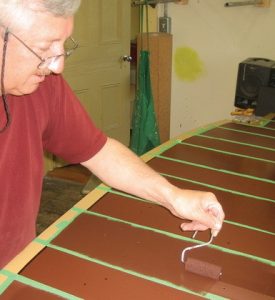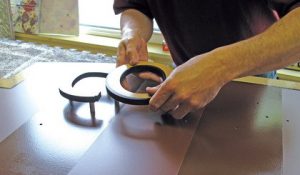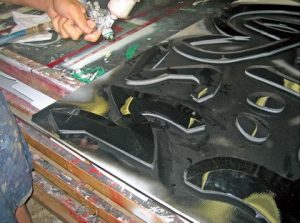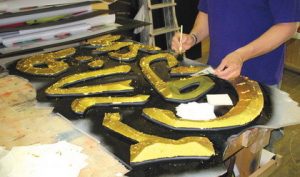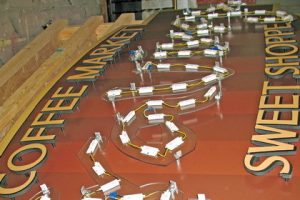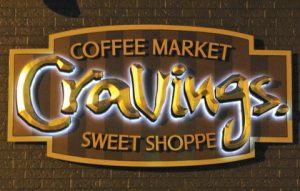I’ve enjoyed creating a niche for my shop, Abracadabra Signs (Ayr, ON, Canada). After years as a traveling signpainter, I moved back to Ontario to settle down permanently in 1999. I grew my business to include custom, 3-D signage. Thanks to my cartooning background, I often look for, and get, off-the-wall projects (see ST, April 2004, page 62).
Through good work, word-of-mouth and effective marketing, I’ve often earned repeat business from loyal customers, such as Peter and Andy Lerikos. In the past, I’ve created signage and graphics for Crabby Joe’s, the brothers’ restaurant franchise. This spring, they hired me to create unusual channel letters for their newest venture, the Cravings Café. We used diverse materials: high-density urethane (HDU), PVC, goldleaf, two-part epoxy, lettering enamel and LEDs, among others.
The craft
My original design evolved from a sketch created on a brown, kraft-paper napkin during a meeting with the Lerikos brothers. CorelDraw X3 enabled our overall concept design. I like many of X3’s helpful capabilities, such as the power clip, which enables me to change an image’s shape without cropping.
Using EnRoute® 3-D software, we created our HDU-routing profile. We transferred the profile to our MultiCam 1000 CNC router. We used 2-in.-thick, 18-lb. material to create firm letters. After we’d routed them, we decorated it with two coats apiece of polyester-resin primer and black, 1Shot® lettering enamel.
Advertisement
We MIG welded the 4 x 8-ft., curved, aluminum backer, and primed it with automotive primer, and decorated it with 1Shot paint and Spraylat flattening paste. To create a flat finish, we mixed the paste and paint in equal parts. We taped off the sign’s outside border and painted the surface with tan 1Shot. Enamel hardeners aid the enamels’ durability.
To gild the HDU letters, we prepared them with 1Shot fast size — which sets up tack in less than one hour – tinted with 1Shot imitation gold. To decorate them, we used Sepp Leaf’s 22k, patent leaf, which can easily be applied by hand, rather than with the gilder’s tip required for surface leaf. We had to burnish them outside to prevent stray gold from decorating our computer’s hard drive. Using Magic Smooth two-part epoxy, we adhered the HDU letters to the aluminum channel-letter faces.
The secondary lettering, “Coffee Market” and “Sweet Shoppe,” comprises 1/2-in.-thick, black PVC. We pin-mounted the letters with aluminum studs into the backer and decorated the face with Avery Graphics’ A6 opaque, cast, tan vinyl.
Light up my life
Advertisement
This project differed from many of our past efforts because LED halo lighting illuminates the backer panel. As an artist, my job is to design and create. I’m not, and don’t aspire to be, an expert on sign lighting and wiring. Luckily, staff member Eric Tomlinson, a former aerospace engineer, handles electrical wiring and fabrication.
We chose reverse-halo lighting’s a soft, elegant effect for the channel letters. The letters comprise .080-in., aluminum faces and .063-in. returns whose interiors we painted with a flat-white, reflective coating.
To diffuse the light’s reflection onto the back panel, we fastened 1/4-in.-thick, clear Lexan® polycarbonate to the returns’ interiors. We attached 2-in.-long, US LED Pinnacle 12V, white modules – powered by an Advance transformer — to the Lexan face with brackets that secure the 14-gauge cable that connects the wires to the remote-mounted transformer box. We also used high-bond, 3M tape to secure the modules to the polycarbonate. We raised the Lexan panels roughly an inch above the returns’ surfaces to emit diffused light onto the back panel.
For channel-letter projects, LEDs offer multiple benefits. According to Tomlinson, one powersource operates the entire system and fits neatly within a 4 x 12 x 2 in. box. This transformer only pulls 0.7mA of energy, whereas a neon transformer could generate up to 70mA. This saves the customer significant money, and simplifies safe installation.
Advertisement
LEDs reduce transportation hazards. In the past, as much as 10% of neon tubing would break en route to the installation site, which triggered costly repairs. A neon transformer’s significant weight and intricate wiring also made installations more challenging. Thus, Abracadabra fabricates its electric signs exclusively with LEDs.
The owners wanted the backer flush to the concrete wall, so installation was relatively straightforward. Anchors secure the mounting brackets to the wall; we drilled holes to nestle deck screws that secure the signface to the wall. For easy on/off operation, Tomlinson installed a toggle switch on the transformer box.
Before Craving Café opens, our shop will also produce the eatery’s interior menuboards, window graphics and other promotional POP materials. Signshops should increasingly broaden their horizons to stay competitive. LEDs’ ease of use and energy savings should encourage other historically non-electric signshops to consider similar expansion.
Equipment and Materials
Adhesive: Magic Smooth two-part epoxy, available from Abracadabra Signs, (519) 632-5220 or www.abracadabrasigns.com; high-bond tape, available from sign- and building-supply stores.
Coatings: 1Shot® lettering enamel, from One Shot LLC (Gary, IN), (219) 949-1684 or www.1shot.com; Starbrite White reflective coating, from Spraylat Corp. (Chicago), (800) 443-0244 or www.spraylat.com; polyester-resin primer and finish-flattening paste, from Spraylat.
Goldleaf: Patent, 22k goldleaf, from Sepp Leaf (New York City), (800) 971-7377 or www.seppleaf.com; Fast size, from One Shot LLC; cotton batting and burnishing tools, from art- and sign-supply shops.
Hardware: Deck screws, pin-mounting screws, brackets, anchor bolts, transformer box and toggle switch, available from home-improvement and building-supply stores.
LEDs: Pinnacle white LEDs and transformer, from US LED (Houston), (866) 972-9191 or www.usled.com
Plastic: Lexan® clear polycarbonate, from GE Plastics (Pittsfield, MA), (413) 448-7110 or www.geplastics.com.
Router: CNC 300 Series router, from Multicam LP (Dallas), (972) 929-4070 or www.multicam.com.
Software: CorelDraw® X3, from Corel Corp. (Ottawa, ON, Canada), (800) 772-6735 or www.corel.com; EnRoute® 3-D software, from SA Intl. (Philadelphia), (800) 229-9068 or www.saintl.biz.
Substrates: Two-in.-thick, 18-lb. Sign*Foam® HDU, from Signs Arts Products Corp. (Capistrano Beach, CA), (800) 338-4030 or www.signfoam.com.
Vinyl: Cast, opaque vinyl, from Avery Graphics (Painesville, OH), (800) 231-4654 or www.averygraphics.com
More about Steve
Steve Thomas Greer, founder of Abracadabra Murals (Ayr, Ontario, Canada), began his artistic career as a mural painter who traversed North America developing restaurant signage. Eight years ago, he built a larger shop and began fabricating dimensional signage and graphics. Today, his shop has grown into a five-employee enterprise that exclusively creates signage and graphics for the Pita Pit, a quick-service eatery with many college-town locations; vehicle graphics; A-frame, sidewalk signs; and unique, window and building spectaculars. Recently, the shop adopted LED-lit, channel-letter fabrication, which, according to Greer, didn’t require much additional equipment or capacity.
Greer and his wife, Dana, have two daughters, Gabi and Gracie.


 Tip Sheet3 days ago
Tip Sheet3 days ago
 Business Management1 week ago
Business Management1 week ago
 Women in Signs2 weeks ago
Women in Signs2 weeks ago
 Real Deal4 days ago
Real Deal4 days ago
 Editor's Note1 week ago
Editor's Note1 week ago
 Line Time2 weeks ago
Line Time2 weeks ago
 Product Buying + Technology1 week ago
Product Buying + Technology1 week ago
 Women in Signs4 days ago
Women in Signs4 days ago